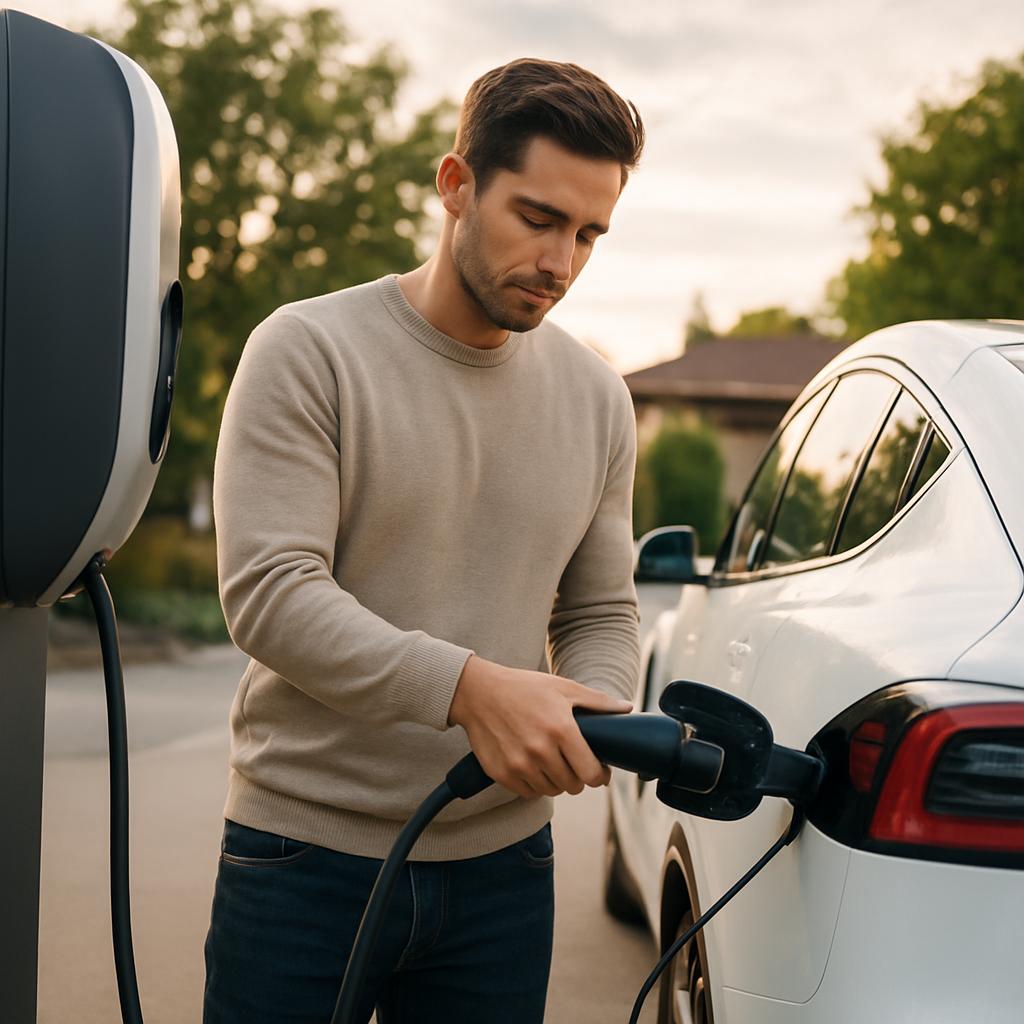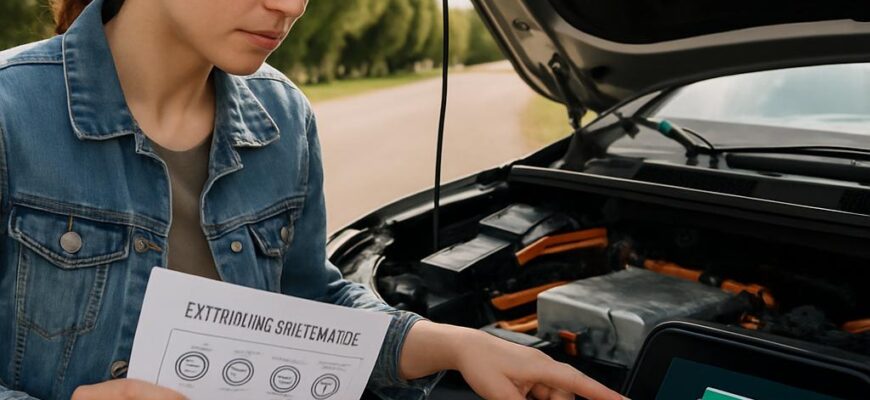Electric vehicles feel different from the moment you slide behind the wheel: instant torque, quiet operation, and a battery that quietly defines the car’s lifespan. Yet batteries don’t need to be mysterious or fragile if you learn a few straightforward habits that preserve their capacity and performance. In this piece I’ll share practical, evidence-based techniques — and a few personal anecdotes — for prolonging battery life without turning driving into a chore.
- Understanding how EV batteries age
- What battery chemistry means for longevity
- Daily charging habits that preserve capacity
- Why partial charging is better than frequent full cycles
- Choosing when and how to use fast charging
- Practical fast-charge tips
- Temperature control: the silent life-saver
- Storage and long-term parking
- Driving style and its effects on battery life
- Use of driving modes and regeneration settings
- Software, updates, and battery management systems
- Understanding warranty and diagnostic tools
- Maintenance beyond the battery
- Cost-benefit thinking: when to prioritize longevity
- Practical checklist: daily, weekly, and long-term
- A quick reference table: charging types and battery impact
- Myths and misconceptions
- When to contact a professional
- Final practical habits to live by
Understanding how EV batteries age
Before changing habits, it helps to understand what actually weakens a lithium-ion battery. Two main processes drive aging: calendar aging, which happens over time even when a battery sits unused, and cycle aging, which accumulates each time you charge and discharge the pack. Both are influenced by temperature, state of charge, depth of discharge, and charging speed.
Knowing the causes makes smart choices easier. For example, keeping a battery at extreme state-of-charge extremes or exposing it to high temperatures accelerates chemical reactions that degrade electrode materials. Once you grasp those links, everyday decisions — like how full to charge or when to fast-charge — start to look less arbitrary and more strategic.
What battery chemistry means for longevity
Not all EV batteries are identical. Most modern EVs use variants of lithium-ion chemistries that trade energy density, cost, and longevity. Nickel manganese cobalt (NMC) packs favor energy density but historically showed faster degradation than lithium iron phosphate (LFP) in some conditions, while LFP chemistry is known for long calendar life and tolerance of full charges. Manufacturers are also refining cells and battery management systems, so real-world behavior varies by make and model.
When shopping or planning long-term ownership, check the specific chemistry and warranty structure. A car with an LFP battery might tolerate frequent full charges better, while another with NMC could benefit more from conservative charge patterns and temperature control strategies.
Daily charging habits that preserve capacity

One of the biggest levers you control is how often and how fully you charge. Charging to 100% every night is convenient but stressful for many battery chemistries. Most manufacturers recommend charging to a daily limit between 70% and 90% for routine use, reserving 100% for long trips. This reduces time spent at high state-of-charge where degradation rates climb.
I follow a practical rule: set the car to charge to about 80–85% for daily commuting and only top to 100% the evening before a planned road trip. Over years of ownership this habit reduced range anxiety without noticeable loss of convenience, and I avoided unnecessary strain on the battery pack.
Why partial charging is better than frequent full cycles
Deep discharges and full recharges cause larger lithiation and delithiation swings, which strain electrode materials. Smaller, shallower cycles—charging from 30% to 80%, for example—produce fewer damaging effects per unit of energy moved through the battery. That’s why “topping up” frequently often results in less cumulative wear than repeated full cycles.
Of course practicality matters: if your commute leaves you low, charge enough to meet daily needs. The key is to avoid habitually keeping your battery near empty or full, and to use intermediate charge windows when possible.
Choosing when and how to use fast charging
Public DC fast chargers are immensely useful but come with a trade-off: higher current and rapid temperature rise accelerate some aging mechanisms. Using fast chargers occasionally is fine and often unavoidable on long trips, but making them your daily routine can shorten battery life. Aim to rely on Level 2 (AC) charging at home for regular replenishment.
When you must use fast charging, consider timing and battery state. Starting a fast charge when the battery is already near full slows acceptably, but beginning when the pack is at very high or very low temperatures can increase stress. Many EVs have thermal management that mitigates this, so preconditioning the car (heating or cooling the battery before arrival) helps.
Practical fast-charge tips
On road trips I typically fast-charge in the middle of the trip rather than at the beginning or end of the day, letting the battery cool between sessions. I also aim to top-up to an 80–90% target and move on; the final 10–20% of a fast charge is the slowest and hottest part of the session and contributes disproportionately to wear. These small tactics shave aging without compromising travel time much.
If your car supports scheduled charging, set it to delay fast charging when the battery is warm from driving and instead begin when the pack has cooled slightly. That reduces the thermal stress the battery sees during the high current phase.
Temperature control: the silent life-saver
Temperature is the most powerful external factor in battery degradation. High heat accelerates chemical breakdowns; prolonged cold can temporarily reduce capacity and increase internal resistance. The good news: modern EVs have thermal management systems, but driver choices still matter. Park in shade when possible, and avoid leaving your vehicle sitting in direct sun with a near-full state of charge for long periods.
In winter, preconditioning the car while still plugged in warms the battery and cabin, improving immediate range and reducing the need for aggressive charging to compensate. In summer, use covered parking and climate control scheduling to maintain moderate battery temperatures. These habits preserve chemistry on both ends of the climate spectrum.
Storage and long-term parking
If you expect to store an EV for weeks or months, don’t leave the battery fully charged or totally depleted. Many manufacturers recommend storing at roughly 40–60% state-of-charge with the vehicle turned off and periodically checking level and temperature. This reduces calendar aging compared to leaving the pack at extreme states for long stretches.
For seasonal vehicles or second cars, plug-in maintenance modes that keep the battery in a mid-level range are ideal. If that’s not an option, check the manual for the recommended storage level and plan a brief top-up or discharge every few weeks to keep the battery chemistry stable.
Driving style and its effects on battery life
Driving habits influence how often and how deeply you cycle the battery. Aggressive acceleration and frequent high-speed driving increase energy throughput and can raise battery temperatures, both of which accelerate aging. Smooth acceleration, steady speeds, and using cruise control on highways help reduce stress. You’ll also notice better efficiency and range.
Regenerative braking helps recapture energy, but it’s not a cure-all. Heavy reliance on regen is fine, yet extremely aggressive stop-and-go driving increases cycles and can slightly reduce long-term lifespan if it means more intense charging afterwards. Balancing spirited driving with calmer patterns will keep the battery healthier over time.
Use of driving modes and regeneration settings
Most EVs offer selectable driving modes and adjustable regen levels. Eco or Efficiency modes damp throttle response and limit power output, reducing thermal load and the rate of discharge. Likewise, moderate regen settings recapture energy without inducing harsh, frequent micro-cycles that might confuse driving rhythm. Experiment to find settings that match your commute and conserve charge.
On my daily route, a mild regen setting and Eco mode let me coast comfortably while still arriving quickly when needed. Small changes in throttle behavior and anticipating stops often save more battery stress than switching regen from its highest to lowest setting.
Software, updates, and battery management systems
Automakers constantly refine battery management through software updates that can improve range, charging behavior, and longevity. These updates may adjust ideal charge windows, thermal management thresholds, or charging curve profiles. Keep your vehicle’s software current and read patch notes — some updates explicitly aim to extend battery life.
Beyond manufacturer updates, familiarize yourself with the car’s built-in battery management settings. Many cars allow you to set a daily charging limit, enable preconditioning, and monitor battery health metrics. Use these controls proactively rather than leaving everything at default.
Understanding warranty and diagnostic tools
Battery warranties are an important safety net and vary widely. Common protections include minimum state-of-health guarantees for eight years or 100,000 miles, but specifics differ. Know what your warranty covers and document any rapid capacity loss early, since warranties often require proof or diagnostic visits within a certain time window.
Many dealers and independent shops now offer battery health diagnostics that report remaining capacity and cell balancing. I used a dealer diagnostic when I noticed a slight capacity shift in an early EV I owned; the assessment was reassuring and saved me money by showing the pack was within expected degradation bounds rather than failing.
Maintenance beyond the battery
Battery life is also indirectly affected by general vehicle maintenance. Tires with correct pressure and alignment reduce rolling resistance and unnecessary load on the powertrain, improving efficiency and reducing energy throughput through the battery. Brake maintenance and drivetrain servicing ensure energy is used where it should be, not wasted by friction or misalignment.
Keep software-driven features like climate preconditioning and charging schedules in good order. Even simple habits like maintaining good cabin air filters reduce HVAC load and lower the battery energy required for climate control, especially in extreme weather.
Cost-benefit thinking: when to prioritize longevity
Not every driver needs to micromanage battery health. If you plan to trade a newer car in within a few years, extreme measures yield diminishing returns. But if you intend long ownership or care about resale value and long-term performance, adopting conservative charging and temperature practices pays off. Balance convenience and cost: small, consistent habits are the best return on investment.
For example, routing your daily charging to Level 2 at home with an 80% cap is low-effort and high-impact compared to obsessing over every fast charge. Think in terms of marginal gain: which small changes produce the most battery-preservation per hour of effort?
Practical checklist: daily, weekly, and long-term
Habits stick when you have a simple checklist. Daily actions: set the charge limit to about 80–85%, precondition while plugged in when temperatures are extreme, and avoid fast chargers unless needed. Weekly actions: check tire pressure and update software as available. Long-term: store at mid-level SOC if leaving the vehicle idle and review warranty and diagnostics periodically.
Here’s a compact checklist you can print or save to your phone:
- Daily: charge to ~80%, precondition while plugged in, avoid extreme SOCs.
- Weekly: inspect tires, let battery rest after long fast charges.
- Long-term: store at 40–60% SOC, schedule diagnostics and software updates.
A quick reference table: charging types and battery impact
| Charging type | Typical use | Impact on battery life |
|---|---|---|
| Level 1 (120V) | Occasional, low-power at home | Lowest stress, slow but battery-friendly |
| Level 2 (240V) | Daily home/work charging | Balanced — convenient and gentle |
| DC fast charge | Road trips, quick top-ups | Higher thermal and electrochemical stress if used frequently |
Myths and misconceptions
A few persistent myths cloud good decision-making. One is that batteries “remember” charge patterns like old NiMH cells; modern lithium-ion batteries don’t suffer memory effect. Another myth is that a single full charge will ruin the pack—damage accumulates gradually, not instantly. Separating fact from fear helps you adopt effective practices without anxiety.
Don’t let marketing or anecdote replace data. If a community forum claims a certain behavior causes immediate failure, check manufacturer guidance and reputable studies. I once read a thread blaming a software update for rapid degradation; dealer diagnostics later showed normal aging consistent with mileage, not the update itself.
When to contact a professional
If you notice sudden, significant range loss, irregular charging behavior, or frequent warning lights, contact your dealer or a qualified EV technician. Small anomalies are often fixable by recalibration or software fixes, while larger failures may be covered under warranty. Early diagnosis often keeps repair costs and permanent damage down.
Maintain records of unusual events and your charging habits — technicians use that context for diagnostics. If a battery degrades faster than expected, having receipts and a documented charging history helps in warranty claims and service negotiations.
Final practical habits to live by
Adopt a few high-impact routines and they’ll protect your battery without ruining your life. Charge mostly to 80–90%, avoid daily fast charging, park smartly to avoid heat, and keep software and tires in check. These choices reduce both calendar and cycle aging in simple, sustainable ways.
Remember that small, consistent changes add up. A slightly more mindful approach to charging and driving can extend usable battery life by years, preserve resale value, and keep daily driving more predictable and enjoyable.
For deeper reads, comparative tests, and the latest EV software and battery research, check out related materials on our site: https://themors.com/technology-innovation-news/. If you want a broader tour of electric vehicle topics and long-form guides, explore more articles at https://themors.com/.









